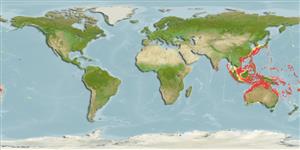Environment: milieu / climate zone / depth range / distribution range
экология
морской демерсальный; пределы глубины 4 - 390 m (Ref. 9824). Tropical
Eastern Indian Ocean and Western Pacific: Bay of Bengal to southern Japan, Taiwan, New Caledonia, and several areas of the Indo-Australian Archipelago (Ref. 9824).
Size / Вес / Возраст
Maturity: Lm ? range ? - ? cm
Max length : 24.0 cm TL самец/пол неопределен; (Ref. 9824)
колючие лучи спинного плавника (общее число) : 0; членистые (мягкие) лучи спинного плавника (общее число) : 100 - 114; колючие лучи анального плавника: 0; членистые (мягкие) лучи анального плавника: 78 - 91. Mouth rather small, contained2. to 2.6 times in head length, maxillary extending to below the anterior margin or anterior 1/3 of lower eye. Gill rakers present on upper limb. Caudal fin with 2 simple rays on upper and lower margins. In the male, several anterior dorsal rays somewhat elongated.
Inhabits sandy substrates in coastal bays to deep offshore (Ref. 48637). Feeds on benthic animals.
Life cycle and mating behavior
Maturities | размножение | Spawnings | Egg(s) | Fecundities | личинки
Masuda, H., K. Amaoka, C. Araga, T. Uyeno and T. Yoshino, 1984. The fishes of the Japanese Archipelago. Vol. 1. Tokai University Press, Tokyo, Japan. 437 p. (text). (Ref. 559)
Статус Красного Списка МСОП (Ref. 130435)
Угроза для людей
Harmless
Использование человеком
рыболовство: интереса не представляет
дополнительная информация
инструменты
Специальные отчеты
Скачать в формате XML
ресурсы в Интернет
Estimates based on models
Preferred temperature (Ref.
123201): 16.4 - 27.8, mean 23.6 °C (based on 607 cells).
Phylogenetic diversity index (Ref.
82804): PD
50 = 0.5000 [Uniqueness, from 0.5 = low to 2.0 = high].
Bayesian length-weight: a=0.00912 (0.00408 - 0.02036), b=3.05 (2.87 - 3.23), in cm total length, based on LWR estimates for this (Sub)family-body shape (Ref.
93245).
Trophic level (Ref.
69278): 3.5 ±0.37 se; based on food items.
устойчивость к внешним воздействиям (Ref.
120179): средний (среднего размера), минимальное время удвоения популяции 1.4-4.4 года (Preliminary K or Fecundity.).
Fishing Vulnerability (Ref.
59153): Low vulnerability (14 of 100).
